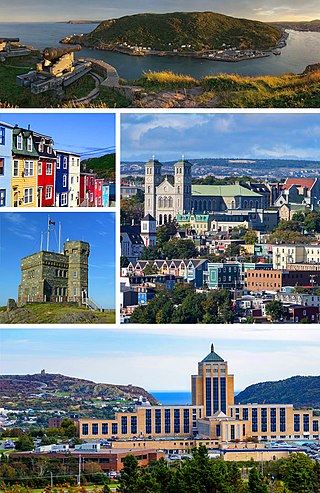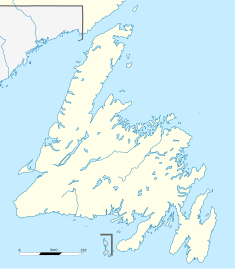
St. John's is the capital and largest city of the Canadian province of Newfoundland and Labrador. It is located on the eastern tip of the Avalon Peninsula on the island of Newfoundland.

The Great Fire of 8 July 1892 in St. John's, Newfoundland and Labrador is remembered as the worst disaster ever to befall that city. Previous "Great Fires" had occurred in St. John's, during 1819 and 1846.

The Newfoundland Railway was a narrow-gauge railway that operated on the island of Newfoundland from 1898 to 1988. With a total track length of 906 miles (1,458 km), it was the longest 3 ft 6 in narrow-gauge system in North America.

The Bank of British North America was founded by royal charter issued in 1836 in London, England. British North America was the common name by which the British colonies and territories that now comprise Canada were known prior to 1867. The bank had offices in Toronto, Upper Canada; Montreal and Quebec City, Lower Canada; Saint John, New Brunswick; Halifax, Nova Scotia; and St. John's, Newfoundland.

St. Anthony is a town on the northern reaches of the Great Northern Peninsula of the Canadian province of Newfoundland and Labrador. St. Anthony serves as a main service centre for northern Newfoundland and southern Labrador. St. Anthony had a population of 2,180 in 2021, compared with 2,258 in 2016, 2,418 in 2011, 2,476 in 2006 and 2,730 in 2001.

The Basilica-Cathedral of St. John the Baptist in St. John's, Newfoundland and Labrador is the metropolitan cathedral of the Roman Catholic Archdiocese of St. John's, Newfoundland and the mother church and symbol of Roman Catholicism in Newfoundland. The building sits within the St. John's Ecclesiastical District, a National Historic District of Canada.

The Cathedral of St. John the Baptist is located in the city of St. John's, Newfoundland and Labrador, Canada.

The Rooms is a cultural facility in St. John's, Newfoundland and Labrador, Canada. The facility opened in 2005 and houses the Art Gallery of Newfoundland and Labrador, the Provincial Archives of Newfoundland and Labrador and the Provincial Museum of Newfoundland and Labrador.

The Colonial Building is a historic government building located in St. John's, Newfoundland and Labrador, Canada. The building was the home of the colonial and later provincial Newfoundland government and the House of Assembly from January 28, 1850 to July 28, 1959. In 1974, it was declared a Provincial Historic Site.

Anderson House is a wooden, two and one half storey hip roofed heritage-designated building located at 42 Powers Court, St. John's, Newfoundland and Labrador. It is a Vernacular Georgian style building and is reported to be one of the oldest structures in the city of St. John's.
The Newfoundland Bank Crash of 1894, known as Black Monday, was one of the turning points in Newfoundland's pre-Confederation history.

The LSPU Hall is a large wooden structure in St. John's, Newfoundland and Labrador. Located on 3 Victoria Street, it is currently the home of the Resource Centre for the Arts (RCA). The name comes from a previous owner, the Longshoremen's Protective Union. The Hall is a registered heritage building.

Clarke's Beach is a town on Conception Bay in the Canadian province of Newfoundland and Labrador. In the 2021 census the town had a population of 1,400. It is the home of a number of well-known Newfoundland artists, and is a favourite place for retirement.
The architecture of St. John's, in Newfoundland and Labrador, Canada, has a style distinct from that of the rest of Canada, and its major buildings are remnants of its history and prestige as the first British colonial capital. The city of St. John's has had a long history, with inhabitation dating to the 16th century onwards. As the city grew, so, too, did the landscape. Buildings took a variety of styles according to the styles and means available to build the structures. Starting as a fishing outpost for European fishermen, St. John's consisted mostly of the homes of fishermen, sheds, storage shacks, and wharves. Of course, these structures were small and constructed out of wood. Like many other cities of the time, as the Industrial Revolution took hold and new methods and materials for construction were introduced, the landscape changed as the city grew in width and height. The Great Fire of 1892 destroyed most of the downtown core, and most residential and other wood-frame buildings date from this period. Often compared to San Francisco because of its hilly terrain and steep maze of residential streets, housing in St. John's is typically painted in bright colours, unlike most other parts of Canada.

The St. John’s Court House is located on Water Street and Duckworth Street in St. John’s, Newfoundland and Labrador. Constructed in 1901–04, the building is a National Historic Site of Canada. Sources differ with regard to its architect; it was designed either by William Tuff Whiteway or by William H. Greene.
The timeline of St. John's history shows the significant events in the history of St. John's, Newfoundland and Labrador.
Richard Harton O'Dwyer (1858–1922) was a Newfoundland merchant and politician. He represented Placentia and St. Mary's in the Newfoundland House of Assembly from 1889 to 1893 as a Liberal.

The members of the 17th General Assembly of Newfoundland were elected in the Newfoundland general election held in November 1893. The general assembly sat from 1894 to 1897.

Fort Townshend is an archaeological site in St. John's, Newfoundland and Labrador that was designated a National Historic Site of Canada in 1951. The original military fort was built, as the headquarters of the British garrison, between 1775-1779, to secure St John's from attacks, from the French, as well as from American privateers, and it was abandoned in 1871. The great star-shaped citadel was one of the largest British fortifications in North America at the time. The Rooms which houses the Art Gallery, the Provincial Archives and the Provincial Museum, of Newfoundland and Labrador now stands on this site. During the planning and construction of the building much opposition was raised by archaeologists and historians.















